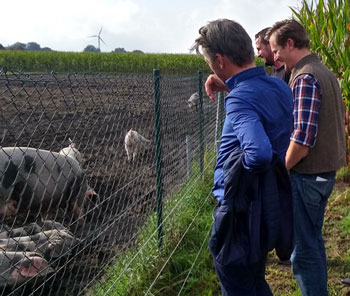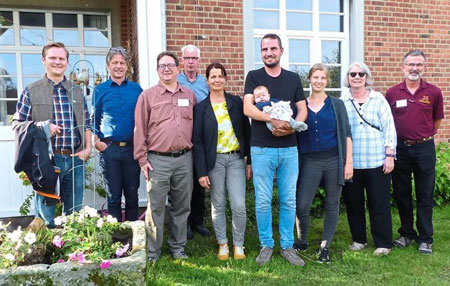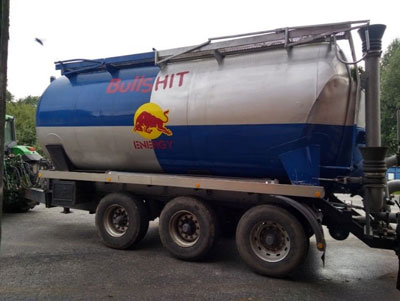October 2021
By Joel Tallaksen, Ph.D., Ag and Energy Scientist
In my WCROC newsletter article from March of this year, What is Agricultural Resilience?, I discussed farm resiliency and the need for farmers to regularly revise their farming practices to meet challenges in a changing agricultural landscape. Earlier this month, I had the chance to visit Saerbeck, Germany as part of the trip organized by the Climate Smart Municipalities (CSM). A delegation of people representing Minnesota companies, government, non-profits, and schools/universities visited the German state of North Rhine-Westphalia to examine how they were implementing renewable energy projects to promote sustainability and economic development. A team from the Morris area visited our sister city of Saerbeck and farms in the surrounding area. Saerbeck is similar to Morris in that it is a fairly small town in a relatively rural area of Germany. Historically, farming has been the largest industry and the farm visits provided good examples of how the Germans were promoting resilience in their farms.
In 2007, Saerbeck began developing and building infrastructure for a unique renewable energy and climate focused strategy to protect the environment, generate revenue for the region, provide employment for their citizens, and serve as an educational platform for students. Several local farmers are participating in these renewable energy efforts as both a way to increase their revenue and help the environment at the same time. Many of the farms we drove by had arrays of solar panels that would supply more energy than their farms would need and were selling the rest to the utility for added income.
As an agriculture and energy researcher, I found it interesting that the German farmers were facing many of the same issues that American farmers face and are using some of the same strategies, including renewable energy, to make their farms resilient in the face of change. Their primary consideration is economics; therefore, farmers are looking at which areas of their operations are profitable and how future changes might affect their profitability. The environmental aspects of farming are also impacting German agriculture as more regulation has been implemented to reduce nutrient runoff and preserve habitat. Another issue faced by farmers is the increasing call, especially by Germany’s youth, for higher animal welfare standards. Combined, these pressures are more intense than they have been in the past. German farmers are quickly working to build more resilient farms that can meet the new realities of farming in their country.
As they consider their options for the future, the farmers are employing new practices that are on the spectrum of adaptation to transformation. Some are changing to more efficient operations to meet current demands, without changing the basic activities that their farm conducts such as raising swine or cattle. While others are looking towards transforming their farms with new activities which they feel will meet their future needs.
These challenges are also forcing farm families to make tough choices as they consider if their sons or daughters will be able to stay on the farm. Most of the farms we visited had family histories that stretched back more than 600 years and there was significant interest from the children to remain in agriculture. We met a number of students doing internships or training at the farms we visited. This suggests that a number of the current agricultural students will have difficulty finding positions in traditional agricultural jobs and not be able to start farms of their own. Therefore, they too must be resilient and develop the new skills that will be needed as agriculture evolves in Germany.
Swine production at the farm of Andreas Puckert
The first farm visit was to the swine farm of Andreas Puckert and his family, who raises 1000 head of hogs per year. Swine production in Germany has been dramatically impacted by the African swine fever virus. With the discovery of this highly contagious swine specific virus in a few wild boars and farms in Germany in 2020-2021, there has been a dramatic decrease in the amount of pork being exported by German producers, reducing prices paid to farmers. Occurring at the same time as relatively high feed prices and increased animal welfare concerns, German swine producers are in a difficult position.
Andreas and his family have chosen to direct market their livestock in an effort to capture some of the income that would go to a meat processor or distributor. Andreas pointed out that the store prices for pork have increased recently, but prices paid to farmers by the meat processors have not similarly increased. Their direct marketing includes hosting people on their farm and showing customers and others that they are concerned about livestock welfare and environmental issues. While these efforts do raise the profile of their farm and provide some new markets for their products, there is not sufficient local meat processing capacity for farmers to direct marketing more than a small portion of their hogs annually. Much like in the US, traditional local butchers are less common and cannot process the volume of animals produced by even a relatively small operation.
All of these factors put producers like Andreas in a tough position. Because the family has an established farm, they can weather some bad years. However, they need to develop solid long-term strategies for maintaining their farm. As they consider their future, the Puckert’s are discussing how their two teenage sons will be able to carry on the farm’s long history. They seemed hopeful that between their direct market efforts and possible improvements in pricing they can maintain the farm into the future.
Diversifying the farm to maintain income

The next farm we visited was that of Torsten Gerling, who had taken over the farm from his father within the last year. As is somewhat traditional in Germany, his parents live in a separate new house on-site, while Torsten, his wife and new daughter, plus his brother live in the historic farmstead house. They were kind enough to invite us into their house for a pre-tour discussion, during which we were seated around a cozy fire in the very impressive 1899 historic hearth. Torsten told us that in the 1100’s the farm had roughly twenty hired workers, but was now operated primarily by him with help from his family. In recent times, the 50-hectare farm focused solely on beef and crops. The economics of farming forced the Gerlings to consider changes to the farm as Torsten became the 15th generation of his family to run the farm, which was first described in documents from the 11th century. To diversify his operations, Torsten and family friends have developed a pasture-based swine production system with the meat direct marketed to customers (www.bauernhof-gerling.de). He has also enrolled parts of his land in the German equivalent of the Conservation Reserve Program. The cattle herd has been limited to a smaller number of bull calves brought from the eastern part of the country and raised to maturity. However, Torsten also maintains a full-time position managing a strawberry seedling farm to provide a stable income to support him and his young family. By establishing this diverse mix of income streams, Torsten is able to limit the risk of a failure in any one of the enterprises he is engaged in.

Organic vegetable production
We also had the opportunity to visit a relatively new organic vegetable farm in the region. The off-site owner worked in the IT sector and was not a farmer by trade, but saw the organic sector as an environmentally responsible investment. The relatively small farm was newly built with facilities to harvest, store, ship and direct market produce. It was designed with computer systems that integrated data throughout the supply chain from sensors in the soil all the way to the online wholesale grocery portal. The heavy data analysis systems help the farm manager in decision making in all areas of operation. Fertilizer and irrigation were determined based on ground sensors monitoring moisture and nutrient testing. Planting dates and seeding numbers were generated based on future harvest dates for the produce and the corresponding orders from stores during the same time in the previous year.
The precision application of nutrients and irrigation is especially important for this farm as it must meet both the environmental regulations for the region and standards for the organic certification group the farm uses. Germany has several well recognized organic ‘brands’ or certifying groups with varying strictness of organic and environmental rules. The “Demeter” brand that this farm sells under is one of the best known and has strict quality, organic, and environmental rules. By using this branding, the farm is able to sell its products for higher prices. However, they must abide by the stricter rules and pass regular inspections. Tracking of produce at the farm appeared to be fairly intense and computerized, with each of the reusable folding plastic transport crates having unique barcodes that can be tracked from the farm to the store. This allows them to optimize shipping and maintain freshness of products being delivered. The farm also had a small store area where they direct marketed produce one day a week. The farm’s business model was to deliver a high-quality product that the customers would prefer and be willing to pay extra for. As a new operation, they were not yet in a position to say how they felt the model was working yet.
Beef and biogas production
Our next visit was to a farm run by Manni Stallfort and his son that had evolved from a dairy and beef operation to a beef and bioenergy operation. It also includes the crops needed to support the livestock and bioenergy operations. Manni’s family had been running a traditional dairy operation and selling fattened bull calves from the dairy herd in the past. He converted the facilities he had to beef production and expanded to a nearby rented barn, then began importing Angus bull calves from the eastern part of Germany and raising them to maturity. In Germany, it is typical to raise bull calves for beef production as castration is not done due to animal welfare concerns. This increases the amount of time required for fattening the cattle, thus feed and housing costs are increased. By focusing the livestock operation on beef cattle only and enlarging it, Manni had set up a more efficient system for producing beef.

Manni also looked for other areas where his farm could bring in revenue. Seeing an opportunity in the energy sector, he partnered with 16 other regional farms to build an anaerobic digestion facility for biogas production. The cooperative they formed is responsible for supplying cattle manure and plant biomass to the biogas facility they own, which is located at the Saerbeck Bioenergy Park. An issue that several farmers mentioned was that manure application was becoming more restrictive as environmental rules have been established to reduce runoff. The biogas production facility can receive a portion of the farmers manure year-round, thus helping them avoid issues with filling their manure storage and have no application opportunities. An interesting aspect of biogas production in Germany is that the farmers are using corn silage (with the grain) as the biomass going into the biogas production facility. The economics of supplying biogas or biogas-based electricity allow the farmer to make money selling silage for energy production.
Agroforestry based production of wood chips for the hearing and power industry
The visit with Bernard Böddeker and his family brought us to a small farm that was set up to process wood into woodchips for heating use (www.holzboeddeker.de). Since their operation mostly required space for storing wood and chips, the overall farm size appeared fairly small. While the farm still maintained a small flock of sheep, the business was mostly focused on the wood chipping operations. The sheep were mainly a therapeutic hobby for Bernard, who was very proud to show them off to fellow sheep enthusiast Lee Johnston from WCROC. The farm’s history was first documented in 1476, and the Böddeckers were the 10th and 11th generation of the family on the land. The recent agroforestry operation was truly a family operation, with one son focusing on operations of the wood handling, chipping, and drying system and the other, a forester, who was responsible for harvesting and replanting trees.
The Böddeckers’ transition to the wood business roughly coincided with the German transition to renewable energy over the last 20 years. The high value of energy, and particularly renewable energy, in the German market means that a relatively small wood chipping operation can be profitable serving local and regional customers needing chips for heating and renewable energy.
How comparable would these changes be in Minnesota?
These examples from Germany likely represent farms that are proactive or early adopters of new practices and are on the leading edge of resiliency efforts. The changes they are making are designed for the unique situations of their region of Germany. Most of the operations we visited were 120 acres or less (50 hectares), whose land value is roughly 3 times higher than in Minnesota. Thus, it is very difficult for farmers to make any changes that require purchasing new land. Farm commodity and energy prices are also very different in Germany than Minnesota. The average price of electricity is 25-30 cents per kWh, roughly 2-3 times that paid by residents in Minnesota. The power pricing is structured to have a high percentage of added fees that are used to help subsidize renewable energy. Thus, installation of the solar, wood, and biogas systems that we saw were partially paid for by subsidies or received high prices for the renewable energy they produced. The German people believe that developing these renewable energy technologies and a more environmentally sound economy is a long-term benefit and are more willing to pay higher prices as long as the money is well spent.
The changes at these farms are a good example of working with the resources at hand to address long-term resiliency. However, they are not directly replicable in Minnesota. An important consideration for the changes that these farmers made was the economics. The economic situation in Minnesota is much different and the same changes would not be economically viable here. However, the substantial amount of thought, innovation, and hard work from these farmers and their families is what will be needed for Minnesota to address the multiple demands being placed on agriculture as we go forward.
